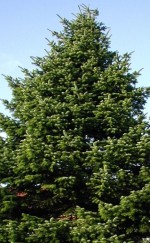 This stately evergreen tree, native to Asia Minor and the Mediterranean, has a dense pyramidal form with many branches from the ground up. Dark, shiny green needles with two white bands on undersides are ¾ to 1¼” long and densely cover the branches. The reddish brown seed cones are 5-6’ long, cylindrical, and are held erect on the upper branches. They are rarely seen, however, because they disintegrate on the tree. The bark is charcoal-gray and smooth with resin blisters. Because of the large size of the tree it is best used in a large landscape such as a park or campus where it can be a specimen, screen, or windbreak. Although it is easy to transplant, it does not withstand harsh environmental conditions and is often damaged by deer. It can be grown in a container for several years when young and makes an excellent Christmas tree in part because it retains its needles for a long time as it dries out. Dwarf forms are available but are not common in nurseries.
This stately evergreen tree, native to Asia Minor and the Mediterranean, has a dense pyramidal form with many branches from the ground up. Dark, shiny green needles with two white bands on undersides are ¾ to 1¼” long and densely cover the branches. The reddish brown seed cones are 5-6’ long, cylindrical, and are held erect on the upper branches. They are rarely seen, however, because they disintegrate on the tree. The bark is charcoal-gray and smooth with resin blisters. Because of the large size of the tree it is best used in a large landscape such as a park or campus where it can be a specimen, screen, or windbreak. Although it is easy to transplant, it does not withstand harsh environmental conditions and is often damaged by deer. It can be grown in a container for several years when young and makes an excellent Christmas tree in part because it retains its needles for a long time as it dries out. Dwarf forms are available but are not common in nurseries.
Type: Evergreen tree
Outstanding Feature: Form
Form: Densely pyramidal
Growth Rate: Slow (8-12”/year)
Bloom: Insignificant
Size: 40-60’ H x 15-20’ W
Light: Full sun
Soil: Average, moist, well-drained, acidic
Hardiness: Zones 5-7
Care: Low maintenance
Pests and Diseases: Susceptible to scales, spider mites, twig aphids, bagworms and woolly adelgids none of which are usually a severe problem.
Propagation: Seed
Outstanding Selections:
 ‘Barabit’’Compacta (dwarf, broad-spreading)
‘Barabit’’Compacta (dwarf, broad-spreading) ‘Golden Spreader’ (flat, round, spreading, bright golden-yellow foliage in winter)
‘Golden Spreader’ (flat, round, spreading, bright golden-yellow foliage in winter) ‘Pendula’ ( wide-spreading semi-prostrate; up to 20’ tall)
‘Pendula’ ( wide-spreading semi-prostrate; up to 20’ tall)